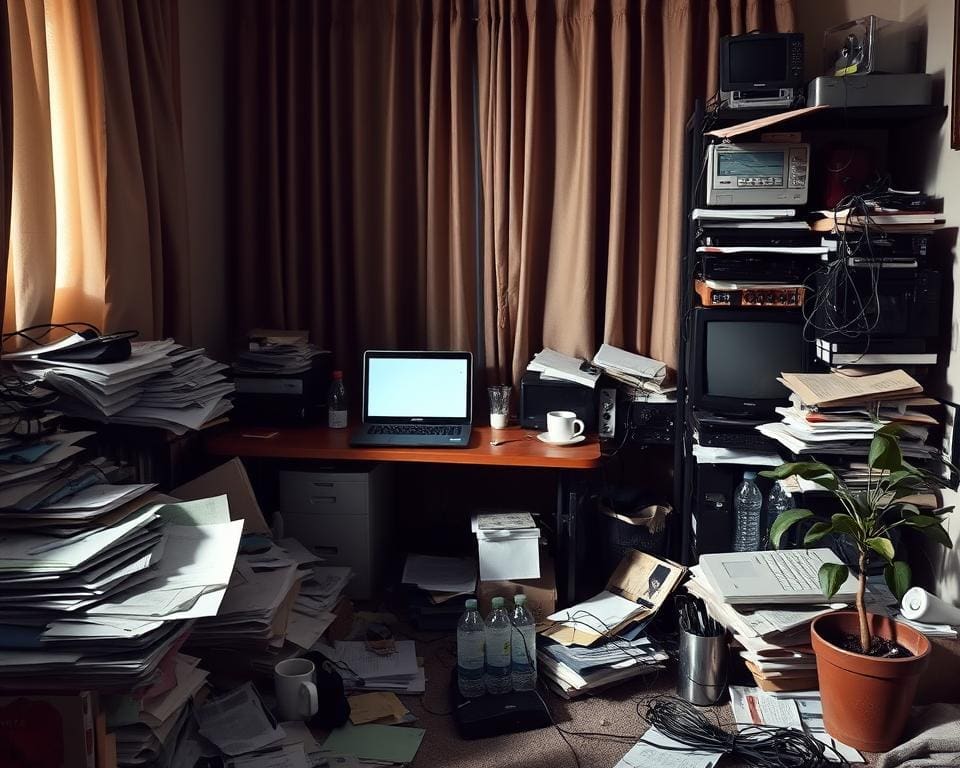As remote working continues to gain momentum, especially following recent global events, understanding what should you never do in a home office has become vital. Common home office mistakes can significantly impact productivity and wellbeing if not addressed. A recent study by Stanford University indicated that remote workers can be 13% more productive than their in-office counterparts, underscoring the importance of cultivating an effective work environment. However, home office blunders such as lounging on your bed or avoiding a dedicated workspace can lead to distractions and inefficiencies. By recognising these pitfalls, you can create a space that fosters both creativity and focus.
Common home office pitfalls to avoid
Working from home offers flexibility and convenience, yet it brings a unique set of challenges. Recognising common home office pitfalls can greatly enhance productivity and wellbeing. Often, a lack of a structured environment serves as a major barrier to effectiveness. Many remote workers find it hard to concentrate when working in shared living spaces or informal settings.
Inadequate technology setups also rank high among the common home office pitfalls. Insufficient bandwidth, outdated devices, or poor software can hinder workflow and lead to frustration. A smooth and uninterrupted connection is vital for maintaining focus and achieving results.
Planning is another critical area often overlooked. Without setting clear goals or schedules, distractions may take over, making it difficult to stay on task. Embracing a proactive mindset can help avert these home office no-nos. Awareness of these issues enables workers to identify potential disruptions, creating a more conducive and efficient workspace.

What should you never do in a home office?
The home office is a sanctuary for productivity, yet many individuals overlook crucial aspects that can significantly impact their work. Understanding what should you never do in a home office can help create a thriving environment. Two common home office mistakes involve neglecting a workspace and overlooking ergonomic setups.
Neglecting a dedicated workspace
Establishing a dedicated workspace is essential for maintaining focus and productivity. Neglecting a workspace can blur the lines between personal and professional life, leading to distractions and decreased efficiency. A distinct area for work not only enhances concentration but also signals to your brain that it is time to engage in professional tasks. Without this clear demarcation, the risk of work-related stress increases.
Overlooking ergonomic setups
Proper ergonomics is vital for long-term health, yet many people make the mistake of overlooking ergonomic setups in their home offices. Poor ergonomic arrangements can lead to discomfort and physical strain. The National Institute for Occupational Safety and Health (NIOSH) stresses the importance of a well-designed workspace. Simple adjustments, such as an appropriately positioned monitor and supportive seating, can prevent long-term health issues. Investing time in creating an ergonomic setup is crucial for sustaining productivity and overall wellbeing.
Home office no-nos that hinder productivity
In a home office setting, certain habits can severely impede productivity. Identifying and avoiding these behaviours can lead to a more efficient work experience.
Working from your bed or couch
Though it may seem relaxing, working from your bed or couch often contributes to significant home office blunders. This behaviour fosters a casual mentality that can diminish focus and undermine professional efforts. Productivity experts highlight that maintaining a formal workspace creates a psychological distinction between work and leisure. Embracing a dedicated workspace promotes better discipline, allowing for enhanced task engagement.
Multitasking with household chores
Many individuals underestimate the impact of multitasking with household chores while working. Juggling these activities often leads to considerable productivity hindrances. Studies reveal that concentrating on singular tasks is essential for maximising output. Attempting to combine work responsibilities with chores commonly results in distraction and decreased efficiency. Setting designated work hours can limit the temptation to multitask, allowing for improved focus on essential tasks.
Home office mistakes that affect wellbeing
Creating a sustainable home office environment involves recognising the impact of certain home office mistakes on your wellbeing. Overlooking essential aspects, such as a work-life balance and the necessity for regular breaks, can significantly hinder both mental and physical health.
Disregarding work-life balance
Many professionals find themselves working longer hours while at home, often leading to a blurred line between work and personal life. This disregard for work-life balance can contribute to heightened stress levels and burnout. Prioritising time for personal activities and relaxation is vital in maintaining overall wellbeing. Implementing boundaries, such as designated working hours, can lead to a healthier approach to remote work.
Ignoring the importance of breaks
Regular breaks serve as essential components in promoting productivity and focus. Ignoring the importance of breaks may result in fatigue and decreased concentration. Adopting techniques, such as the Pomodoro Technique, encourages structured intervals of work and rest. Incorporating short pauses into the daily routine not only supports mental clarity but also benefits physical health. Consider scheduling breaks throughout the day to recharge and refocus.
Avoid home office errors for better focus
Creating an environment that nurtures concentration is essential for productivity. Avoid home office errors that can disrupt your ability to focus, particularly when it involves excessive screen time and poor lighting conditions. Striking a balance and managing external distractions contributes to a healthier work routine.
Excessive screen time without proper lighting
Many professionals underestimate the impact of adequate lighting on their work performance. Excessive screen time can lead to eye strain, particularly in poorly lit spaces. To maintain your focus and minimise discomfort, consider implementing the following:
- Position your screen away from glare sources.
- Incorporate ambient lighting to reduce the contrast between your screen and the surrounding area.
- Utilise anti-glare screens to improve visibility.
- Schedule regular breaks to rest your eyes and reset your focus.
Allowing too many distractions
Home environments frequently present various distractions, from family members and pets to smartphones buzzing with alerts. To enhance your focus, consider these strategies:
- Establish clear boundaries within your household during work hours.
- Create a designated workspace that signals to others that you are working.
- Use technology wisely; mute notifications during critical tasks.
- Incorporate noise-cancelling headphones or calming background music to drown out interruptions.
How to identify home office blunders
Recognising personal home office mistakes can significantly enhance productivity and well-being. Engaging in self-assessment allows individuals to reflect on work habits and environments. It also opens avenues for receiving constructive feedback, which can illuminate areas for improvement that may go unnoticed. Implementing these strategies can lead to a more efficient and satisfying work experience.
Self-assessment questions to consider
Conducting a self-assessment can serve as a powerful tool in identifying home office blunders. Reflective questions may include:
- Am I meeting my daily tasks?
- How do I feel at the end of my workday?
- Do I feel energised or drained after working?
- Is my workspace organised and conducive to productivity?
Honest responses to these questions will provide insights into personal habits and help establish a clearer path towards improvement.
Feedback from colleagues and peers
Feedback from colleagues can offer an invaluable outside perspective when looking to identify home office blunders. Engaging in open conversations allows for a sharing of observations that may not be apparent from your viewpoint. Colleagues can highlight strengths and weaknesses together, fostering an environment of continuous growth and support. Embracing such feedback can reinforce productivity and enhance overall work satisfaction.
Creating an effective home office environment
Building a productive home office requires careful consideration of essential tools and effective workspace organisation. The right setup can turn a chaotic environment into a haven of creativity and focus. By selecting optimal technology and implementing smart organisation strategies, anyone can foster an inspiring atmosphere conducive to success.
Essential tools and technology
Investing in essential tools can significantly enhance productivity while creating an effective home office. Consider implementing organisational software like Trello or Asana, which helps manage tasks and track progress. Productivity apps can also streamline workflow, allowing for better time management.
Smart organisation tips for your workspace
Workspace organisation plays a crucial role in maintaining focus. Start by decluttering your desk and keeping only necessary items within reach. Establish a routine that includes designated times for breaks to refresh your mind. This method not only promotes cleanliness but also cultivates a disciplined approach to work.
Transforming common mistakes into successes
Recognising and addressing mistakes in your home office is the foundational step towards meaningful home office improvement. Instead of viewing setbacks as failures, reframe them as opportunities for growth. For instance, if you find yourself frequently distracted by household tasks, consider implementing structured work sessions that allow for focused productivity followed by planned breaks. This not only enhances your concentration but also allows you to manage chores effectively without compromising work quality.
Success stories abound from individuals who have taken steps to transform their home office environments. Many have shared how redesigning their workspace to include ergonomic furniture and better organisation has not only boosted their comfort but has also led to higher levels of productivity. These improvements serve as a testament to the positive changes that can arise from recognising previous missteps. In doing so, they illustrate a powerful narrative: that it is indeed possible to transform mistakes into successes.
Support from productivity coaches further validates these strategies, providing tailored advice that aids in reshaping one’s work habits. Whether it’s enhancing your workspace with proper lighting or creating a more disciplined daily routine, taking calculated steps can lead to notable improvements. Remember, each mistake is simply a stepping stone towards crafting a more effective and fulfilling home office environment.









